Text
DNA Evidence
DNA can be an effective identifier if used intelligently. What are some potential sources of DNA investigators can use?
Blood is an excellent source of human DNA. DNA is present in white blood cells of humans, but not red blood cells which lack nuclei. A dime-sized spot of blood, approximately 50 µl in volume, is enough DNA for a typical VNTR analysis.
DNA from sperm heads is usually the most important source of DNA evidence for sexual assault cases. Five µl of semen contains approximately the same amount of DNA as 50 µl of blood. Special extraction methods are required to release DNA from sperm heads. Consequently sexual assault samples can be differentially extracted. The first extraction yields primarily DNA from epithelial cells of the victim, and the second extraction yields primarily semen DNA.
Saliva contains cellular material. DNA can be extracted from bite marks, cigarette butts, postage stamps on envelopes, and envelope flaps for DNA analysis. In fact, the “Unabomber” was convicted partially on DNA evidence from a letter-bomb he mailed that did not explode.
The hair follicle at the base of human hairs contains cellular material rich in DNA. In order to be used for DNA analysis, the hair must have been pulled from the body – hairs that have been broken off do not contain DNA.
Any body tissue that has not been degraded is a potential source of DNA.
Bone is one of the best sources of DNA from decomposed human remains. Even after the flesh is decomposed, DNA can often be obtained from demineralized bone. DNA from bone has been used to identify the repatrioted bones from Vietnam era servicemen, and the remains of the White Russian Romanov family who were executed during the Bolsheviek revolution.
Like bones, teeth can also be an excellent source of DNA, long after the rest of the body has decomposed.
Urine itself does not contain DNA, but it may contain epithelial cells, which do contain DNA. Most healthy individuals, however, do not excrete epithelial cells in their urine.
109 notes
·
View notes
Text
Crime Scene Search Method
------
Follow @forensicfield for more info
Join @forensicfield on Telegram for pdf, MCQs, book and much more...
Like the knowlege then Like the post...
----------
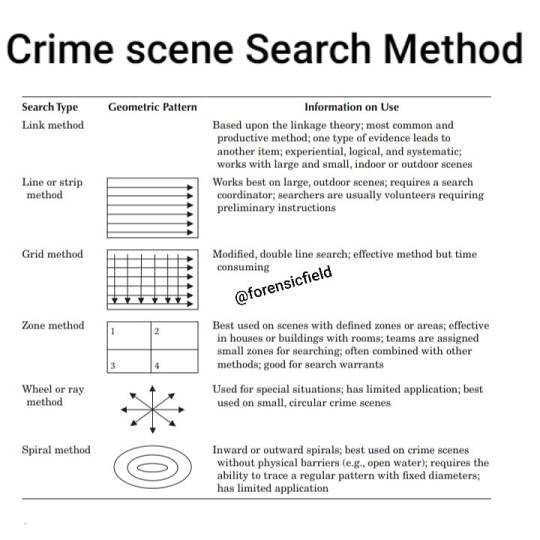

10 notes
·
View notes
Photo

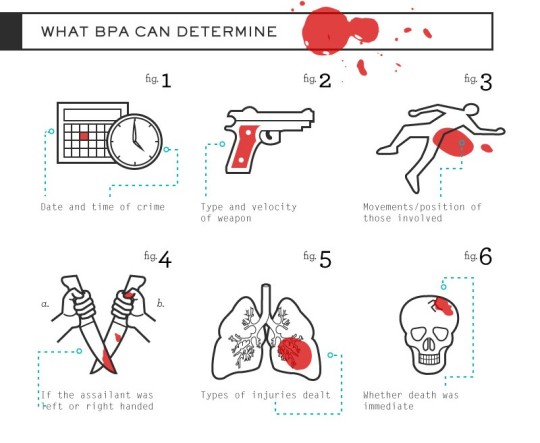
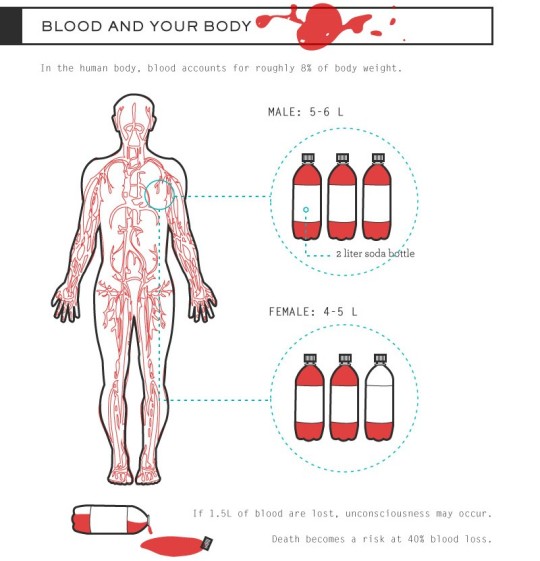
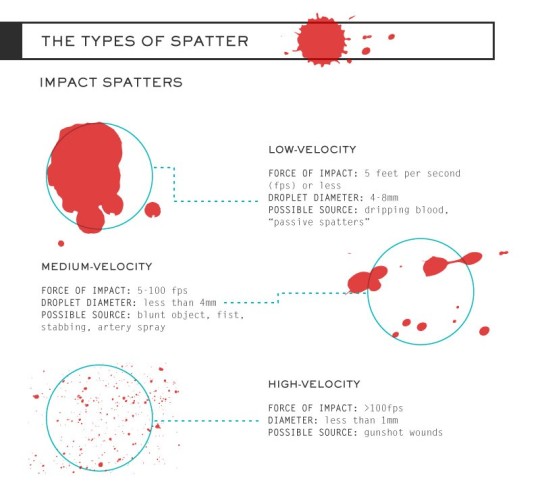
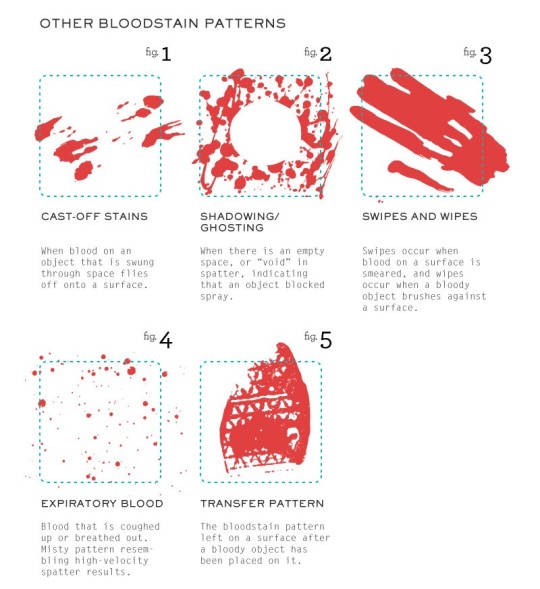

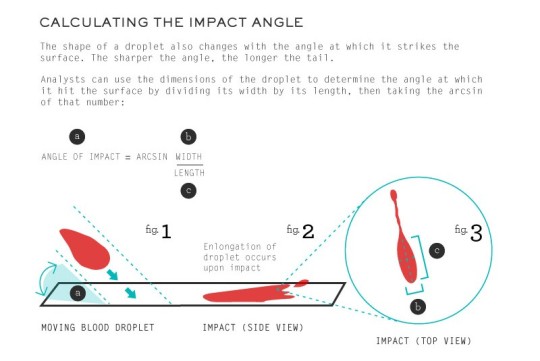
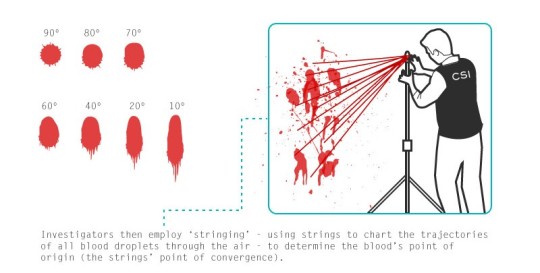
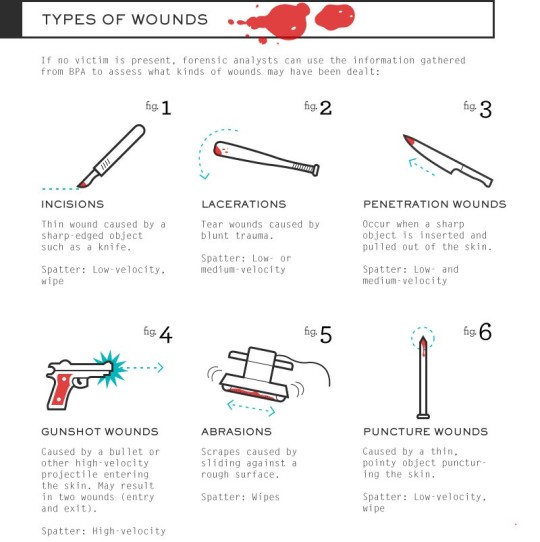
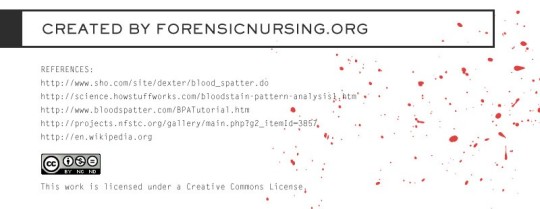
LACERATIONS are mostly NOT blunt force trauma. lacerations tend to be when something splits into two by any kind of force. aka laceration to the liver can be caused by a knife or blunt force trauma that cause the liver to split into two. mush caused by blunt force trauma is NOT a laceration.
also penetration is anything that has been penetrated, including bullets, hence it does not need to be sharp.
and for blood splatter, interior vs exterior environments are important
928 notes
·
View notes
Text
Steps in the analysis of a bloodstain
The first step is to determine if the stain is really blood, and this is accomplished using presumptive tests. These tests involve the use of chemical reagents that change color in the presence of hemoglobin; however, they are not specific and can yield false positive results. Common presumptive tests include phenolphthalein (Kastle-meyer color test), luminol, and orthotolidine. Once a presumptive test indicates that a stain may be blood, a confirmatory test may be performed. These include crystal tests (teichmann, takayama, or Wagenaar tests) or other immunological or spectrophotometric techniques. Confirmatory tests can be accomplished as part of the next step in the analysis, a determination of the species of the blood (human, dog, cow, and so on) using immunodiffusion tests. Human blood will react with human antisera but not with antisera from other species, so a positive result at this stage both confirms the presence of blood and that the blood is human. The final step in the process is to individualize to the extent possible the blood and to compare stains to known blood if comparative samples are available (such as blood drawn from a suspect).
Until recently, this task was accomplished by typing blood for ABO blood group, isoenzyme systems, and other genetic marker systems as appropriate and feasible. However, DNA typing has supplanted ABO and isoenzymes in this capacity. Current DNA methods also can confirm the identification of a substance as blood and that it is human.
------
Follow @forensicfield for more info
Join @forensicfield on Telegram for pdf, MCQs, book and much more...
Like the knowlege then Like the post...


16 notes
·
View notes
Text
stages of fresh decomposition
pallor mortis (paleness of death)
» directly after the death, the blood stops flowing which causes a light skinned person to become extremely pale
algor mortis (cool of death)
» an hour after death, the body will have decreased in temperature by 2 degrees Celsius. the temperature will continue to drop to the surrounding temperature of the environment
rigor mortis (death stiffness)
» three hours after death, the muscles of the body undergo a chemical change and become stiff, starting with the face. by 12-24 hours, maximum rigor is present. stiffness only lasts 1-3 days until the body becomes soft again.
liver mortis (bluish color of death)
» 6-12 hours after death gravity causes the blood to move downwards to the part closest to the ground. the area becomes purple and red
47 notes
·
View notes
Photo
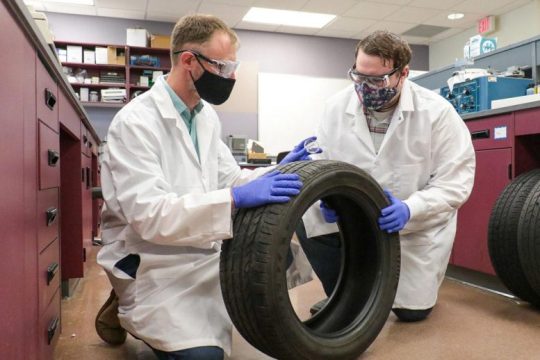
Skid Mark Clues: Forensic Scientists Classify Unique Chemical Signatures in Tires
New approach could provide law enforcement additional tools to track down those who flee a crime scene.
Skid marks left by cars are often analyzed for their impression patterns, but they often don’t provide enough information to identify a specific vehicle. UCF Chemistry Associate Professor Matthieu Baudelet and his forensics team at the National Center for Forensic Science, which was established at UCF in 1997, may have just unlocked a new way to collect evidence from those skid marks.
The team recently published a study in the journal Applied Spectroscopy that details how they are classifying the chemical profile of tires to link vehicles back to potential crime scenes.
“Tire evidence is often overlooked in forensics,” says Baudelet. “In cases of hit and runs or accidents involving multiple cars the chemical signature of the tires have the potential to be integral information to the investigation.”
Read more.
28 notes
·
View notes
Text
A Simplified Guide To
Footwear & Tire Track Examination
Footwear and tire tracks can be deposited on almost any surface, from paper to the human body. Prints are divided into three types: visible, plastic and latent.
A visible print is a transfer of material from the shoe or tire to the surface. This type can be seen by the naked eye without additional aids. For example, bloody shoe prints left on flooring or tracks left by muddy tires on a driveway.
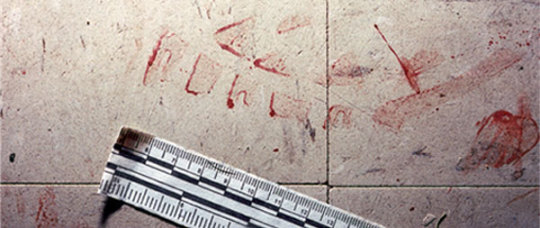
Bloody shoeprints are visible on tile flooring. (Courtesy of John Black, Ron Smith & Associates)
A plastic print is a three-dimensional impression left on a soft surface. This includes shoe or tire tracks left in sand, mud or snow.

Plastic shoeprint left in sand. (Courtesy of Aubrey Askins, Tacoma Police Department)
A latent print is one that is not readily visible to the naked eye. This type is created through static charges between the sole or tread and the surface. Examiners or investigators use powders, chemicals or alternate light sources to find these prints. Examples include shoeprints detected on a tile or hardwood floor, window sill, or metal counter, or tire tracks detected on road surfaces, driveways or sidewalks.

Dust impression left on a masonite surface, illuminated with oblique lighting. (Courtesy of Scott Campbell, Ron Smith & Associates)
How Samples are Collected
Examiners use several methods for collecting footwear and tire track evidence depending on the type of impression found. For impressions in soil, snow or other soft surfaces, casting is the most commonly used collection method. For imprints, examiners generally try to collect the entire object containing the imprint, such as a whole sheet of paper or cardboard with a shoe print. When that is not possible, for instance, if the print is on a bank counter, the examiner would use a lifting technique to transfer the imprint to a medium that can be sent to the laboratory.

Casts are created of footwear impressions to preserve them and allow for comparison and analysis. (Courtesy of NFSTC)
As with any evidence found at a crime scene, shoeprints and tire tracks must be properly documented, collected and preserved in order to maintain the integrity of the evidence. Impression evidence is easily damaged, so steps must be taken to avoid damage to the evidence. This includes securing and documenting the scene prior to collecting any evidence.
In the case of impression evidence, general photographs of the evidence location in relation to the rest of the scene are taken, along with high-resolution images of the individual imprints or impressions. Examiners may use alternate light sources or chemical enhancers to capture as much detail as possible, especially with latent imprints.
Properly photographing impressions is crucial. Since there is only a slight difference between different shoe sizes, if the photographs are not taken at a 90° angle to the impression, then the true size cannot be produced in order to compare to the actual shoe.
Whenever possible, impression evidence is collected as is and submitted to the laboratory for examination. For shoeprints and tire tracks that cannot be picked up, various lifting techniques are used to recover the evidence. These include:
• Adhesive lifter - a heavy coating of adhesive lifts the imprint from smooth, non-delicate surfaces such as tile or hardwood floors, metal counters, etc. It is usually used in conjunction with fingerprint powders.
• Gelatin lifter - a sheet of rubber with a low-adhesive gelatin layer on one side that can lift prints from almost any surface, including porous, rough, curved and textured surfaces. It is less tacky and more flexible than an adhesive lifter, allowing it to pick up a dusty shoeprint on a cardboard box, for example, but not tear the surface of the box.
• Electrostatic dust-print lifting device - a tool that electrostatically charges particles within dust or light soil, which are then attracted and bonded to a lifting film. This method is best for collecting dry or dusty residue impressions on almost any surface, even the skin of a cadaver.
Any plastic, or three-dimensional, footwear or tire impressions can be collected by casting. Casting uses a powdered stone material, such as dental stone, that can be mixed with water and poured into the impression. When it dries, this method creates a three-dimensional model of the impression.
Imprints and impressions may be further processed to enhance or bring out additional minute details. For example, a digital enhancement program such as Adobe Photoshop® can be used to improve the quality of a photographed tire track. Fingerprint powders and chemical stains or dyes can enhance image color or increase the contrast against the background. This enables lifted or casted evidence to be photographed or scanned.
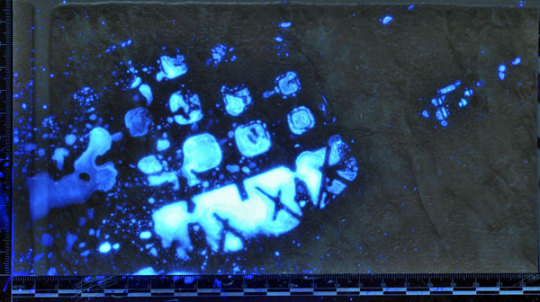
A faint bloody shoe print on linoleum is enhanced by treatment with a chemical, BLUESTAR®, to allow a more detailed photograph to be taken of the evidence. (Courtesy of Erik Savicke, Boston PD)
Comparison samples are usually taken from suspects or suspect vehicles. Shoe samples should be packaged to avoid cross-contamination and tire samples should remain on the vehicle.

A reference print from a tire is captured by inking the tire and driving over paper. (Courtesy of John Black, Ron Smith & Associates)
Who Conducts the Analysis
Evaluation and comparison of impression evidence should be performed by a well-trained footwear and tire track examiner. Typically these professionals have received extensive training on footwear and tire manufacturing, evidence detection, recovery, handling and examination procedures, laboratory and photography equipment and procedures, courtroom testimony and legal issues, and casework.
The Scientific Working Group on Shoeprint and Tire Tread Evidence (SWGTREAD) has a published standard that discusses the minimum qualifications and training for footwear/tire track examiners. Additionally, the International Association for Identification (IAI) offers a recommended course of study for footwear and tire track examiners that takes participants through more than 550 hours of training. The IAI also certifies footwear (but not tire track) examiners.
How and Where the Analysis is Performed
Detection, documentation, photography, and collection of imprints and impressions occur in relation to crime scenes of many types. Analysis of impression evidence is typically performed at a public crime laboratory or private laboratory by experienced examiners.
Evidence Submission and Examination
Ideally, the suspect’s shoes and/or tires are submitted to the lab along with the collected evidence. Examiners will use the submitted shoes and/or tires to make test standards, impressions of a known source, which can then be compared to the collected evidence. This is usually done using transparency overlays or side-by-side comparisons.
For example, in a case from Florida, a bloody shoe print was found on the carpet in the home of a murder victim. The print indicated that there was a hole in the shoe that left the print. Investigators collected and made test prints of the shoes from individuals known to be at the scene near the time of the murder. Footwear examiners were able to identify the perpetrator by overlaying the bloody shoeprint from the crime scene with the test print made from the suspect’s shoe.
In some cases, an investigator may be asked to submit shoes or tires of other individuals for exclusion purposes, such as from a cohabitant of a home or from a first responder to a crime scene.
Tools and Techniques
During the examination and comparison, examiners use tools such as dividers, calipers, special lighting and low magnification. Examiners measure the various elements within the tread design as well as the length and width of the impressions, and then compare those measurements to what is seen in the crime scene print or impressions. Low magnification and special lighting are sometimes used to determine if various characteristics are accidental or something that was created during the manufacturing process.
Examiners perform side-by-side comparisons by placing the known shoe or tire alongside the crime scene print so that corresponding areas can be examined. Test prints are also compared to the crime scene print. Digital images on double or triple computer monitors can also be used during the comparison.
Resources and References
Investigators or examiners often use searchable databases containing reference files of shoe outsoles and tire treads to determine the brand/model of a shoe or tire. The FBI, private consultants and fee-based commercial systems maintain databases with tens of thousands of prints. Often investigators can contact the manufacturer directly to obtain information and images for a specific shoe or tire.
The FBI’s Criminal Justice Information System (CJIS) maintains the Footwear and Tire Tread Files database. The SWGTREAD website contains links, resources, information and videos to assist investigators and examiners.
Some agencies use databases to store crime scene images of shoes and tires, and to search and compare crime to crime. Searching these databases does not find potential “matches” as automated fingerprint identification systems can, but returns tread design “look-alikes” for footwear and tire tread.
50 notes
·
View notes
Text
LMMCU (Lin Manuel Miranda Cinematic Universe)
961 notes
·
View notes
Photo
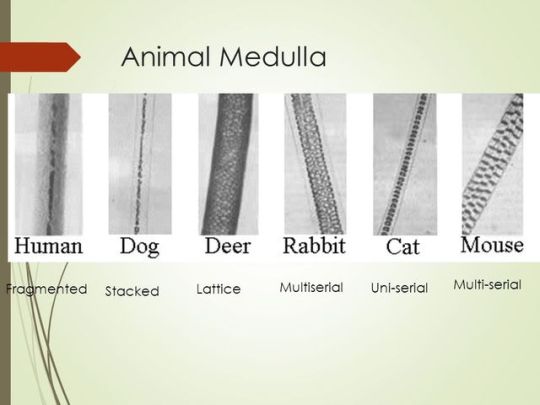

While a lot of you may know that human hair varies from animal hair, do you know WHY it varies, other than its texture and feel?
This question is important, especially during a forensic investigation when they find evidence. How can they tell that the piece of hair that they found on the carpet is from the suspect or the suspect’s cat?
This can be answered when looking under a comparison microscope. There are many aspects that a scientist has to look at in order to differentiate the hairs; the cuticle, the cortex and the medulla.
The cuticle is the outermost layer and is made of dead cells that form scales. They come in 3 patterns: coronal (crown like), spinous (petal like), an imbricate (flattened). Humans usually have imbricate patterns while animals have spinous or coronal.
The cortex helps determine the colour of the hair. This is done by seeing the amount and type of melanin pigment. High concentrations of melanin will be brown/black and low concentrations will be blonde/red. In humans, the density and distribution of these pigments is consistent throughout the hair but in animals, it is usually denser near the medulla or produce sudden changes (banding).
The medulla is the core of the hair strand and it also has 3 patterns: fragmented, intermittent (similar sized fragments) or continuous. In humans, the medulla is less than 1/3 of the overall diameter and the animals, it is greater than 1/3. There are also different structures: uniserial, multiserial, vacuolated, lattice and amorphous.
This is usually looked at if there is no follicular tag, which is a clear piece of tissue surrounding the hair shaft that is rich in DNA. This is more likely found when hair is forcibly removed and if the hair is in its early growth phase.
165 notes
·
View notes
Photo

Estimating time of death on the spot.
Every detective must know how to estimate time of death. Knowledge of time of death will not only answer a lot of questions,but can sometimes be the key to solving a case. That being said, this is a concise guide to on the spot time of death estimation. I would like to point out that this is by no means fully accurate as several factors will affect the rate of post-mortem changes,including but not limited to:
-Age.
-Muscle mass and distribution.
-Location.
-Clothing.
-Weather.
-Pre-mortem physical activity.
But don’t let this discourage you. Estimations don’t mean that they’re wrong, they only mean that they are not extremely accurate, and sometimes all you need is an estimation, as we work with what we have.
There are five famous on the spot methods:
1-rigor morits observation.
2-Pallor mortis observation.
3-Livor mortis observation.
4-Algor mortis observation.
5-Putrefaction observation.
During first 2 hours after death the body goes loose and is quite flexible. Rigor mortis sets in approximately 2 hours after death.
Rigor mortis: (rigor is Latin for “stiff” and mortis is Latin for “death”) is the stiffening of the muscles post-mortem(as seen in the picture below).

Rigor mortis happens because normal living muscle cells use ATP(a form of energy in the body) to transfer calcium ions out of the muscle cells. But, when you die your ATP storage is used up and becomes unable to transfer the calcium ions leading to a calcium ion build up in the muscle cells. This build up cause the muscle fibers(myoscin and actin) to stay linked.
It’s interesting to note that rigor morits start from the top to bottom affecting the facial muscles first. This happens due to the muscle distribution throughout the body. I’ve outlined the rate at which rigor mortis spread throughout the body below.
-Jaw 2hours.
-Arms 4-6hours.
-legs 8-10hours.
-whole body 10-12hours.

Rigor mortis lasts for approximately 72 hours. By using the previous piece of information one can deduce approximately when the person died just by examining the body’s stiffness.
Pallor mortis:(pallor is Latin for"pale") which is the state at which the body goes pale after death. The body goes pale in about 15 minutes post mortem. So it’s useful to know if a body died very recently. Pallor M happens because there is no capillary circulation. Pallor mortis is the first step to livor mortis.
Livor morits: (livor Latin for “bluish in color”). Is the settling of blood on the lower part of the body due to gravity pulling red blood cells. This causes dark discolouration in the lower parts of the body while being pale on the upper parts. Objects causing pressure on the skin will leave a pattern on the skin. LM last from approximately 0-12hours.
Algor mortis: (algor is Latin for cold) is the change of a body’s temperature to the ambient temperature. Basically, the body’s temperature will match that of the environment. In most situations where room temperature is 25, the colder the body the longer it has been dead. Unless you have a thermometer handy and you’re ready to shove it up(or down) someone’s rectum, you’ll just have to estimate the temperature. But, if you do have a thermometer you can use Glaister’s equation below to calculate the time elapsed since death.

Finally, we have, the ugliest part, putrefaction. As with all previous methods, keep in mind, external factors might affect the rate of putrefaction. Putrefaction happens after both rigor and livor mortis have passed. It’s the process at which microorganisms break down tissues and proteins. Some of the products are gasses and volatile chemicals. Here’s an approximate timeline of the stages of putrefaction:
2-3 days: Discolouration and swelling of the abdomen. Gasses form.
3-4 days: Discolouration spreads and veins become visible.
5-6 days: Skin blisters and abdomen noticeably swelled with gas.
2 weeks: Abdomen noticeably tight.
3 weeks: Tissues soften, cavities and organs burst and nails fall off.
4 weeks: Soft tissue begin to liquefy and face becomes unrecognisable.
To conclude, there are multiple ways to estimate the time of death and external factors will affect your estimations. A forensic pathologist will have more accurate estimations, but on the field you’ll have to do with what you have and sometimes what you have is enough. Rigor mortis is the most practical way to estimate time of death on the spot. I hope that you use this piece of knowledge responsibly.
Quaere verum!
434 notes
·
View notes
Photo
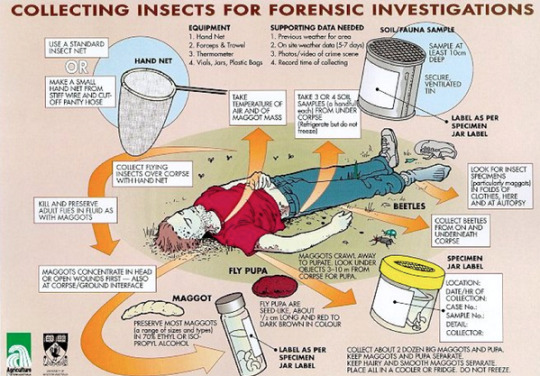
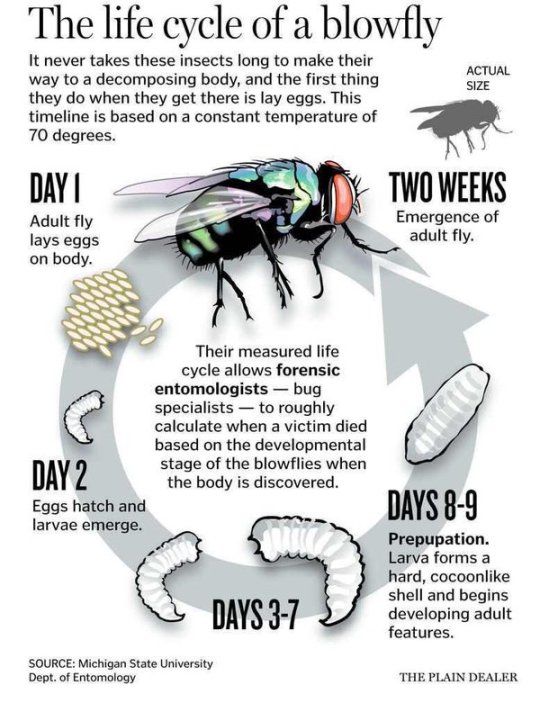
Two diagrams that explain how bugs are used to find out information about a decomposing body.
I found these really interesting and thought I should share. :)
422 notes
·
View notes
Text
What is Criminal Profiling and how Jack The Ripper‘s case contributed to it
Hello and welcome back to Crime, She Wrote! In this post we’ll talk about two things that fascinate me: criminal profiling and the first criminal profile ever recorded. So buckle up, get your favourite beverage and join me in this little trip around criminology!
What is criminal profiling?
Criminal profiling is something that probably most people have heard of thanks to the rising in popularity of crime TV shows, movies and books. It’s safe to say that if you’re reading this, you’ve heard of Criminal Minds, The Silence of the Lambs or Mindhunter. But among all the fiction, what’s the truth? What’s the reality that everything has been based of?
Offender profiling, or criminal profiling, is an investigative technique used by law enforcement agents and psychologists to assist in determining whether offenses were committed by the same perpetrator and to help narrowing down the list of possible suspects by using available information about the crime and crime scene to create a psychological portrait of the perpetrator. As of now, there are several typologies of criminal profiling, such as crime scene analysis, investigative psychology, geographic profiling, diagnostic evaluation and linkage analysis.
What do those words mean?
Crime scene analysis is probably what most people associate offender profiling with: the analysis of a crime scene and inference of the offender’s characteristics from it. Although this is the most popular method of offender profiling and the one used by the FBI, there’s no clear scientific evidence that crime scene actions and offender characteristics can be directly linked without the interfefence of a third factor.
Investigative psychology is a field of applied psychology that attempts to describe and understand the behaviour of the offender, their thought process and psychological characteristics. This is an investigative technique that strays from traditional criminal investigation.
Geographic profiling is, as the name says, the profiling of the area on which the offender commits their crimes. The goal of this investigative tool is to find patterns on the geographical areas in which crimes were committed, narrow down areas where the offender could strike next and find areas of personal significance for the offender. Despite what fictional media might make you believe, this doesn’t necessarily mean the geographic profile tells us where the offender lives (although that’s not impossible), but it tries to link criminal activity to other activities not related to the crimes (such as home or work place, or recreational areas frequently visited by the offender). Geographic profiling works on the principle that 1) crimes are likely to occur near the offender’s home, 2) the offender and the victim must intersect for the crime to occur, 3) the offender tends to divert attentions from their own home although not travelling further away than necessary and 4) crime sites are not random. Although very helpful, geographic profiling is only an accurate tool when investigators have more than three crimes than can be connected to the same offender with no doubt.
Linkage analysis is the process of determining whether several crimes were committed by the same offender. Idealy, this is determined by the presence of DNA, fingerprints or fabric in the crime scenes. But when neither of these are present, investigators must use other ways to determined the facts. One way of doing this is by behaviour linkage analysis where the investigators attempt to link crimes based on the behaviours of the offender. They try to find patterns of behavioral stability and behavioral distinctiveness, aka, the offender must behave a similar way when commiting the crimes and those behaviours must be different form those exhibited by other offenders committing the same crimes. This is also known as the offender’s modus operandi.
Diagnostic evaluation is the attempt to relate psychiatry and psychology knowledge to criminology, thus explaining crime and criminal behaviour via a mental health and psichiatric diagnostic vision.
What does Jack The Ripper have to do with this?
Between April 1888 and February 1891 there were a series of murders around the Whitechapel district of London. The victims were women, typically prostitutes, in impoverished areas, who had their throats cut and their abdomens mutilated, including the removal of the uterus and other organs in most cases. All crimes were committed during the night. Although a total of 11 murders were investigated as being the Ripper’s, only 5 were and are widely accepted as being committed by the Ripper. These are known as the canonical five and consist of Mary Ann Nichols, Annie Chapman, Elizabeth Stride, Catherine Eddowes, and Mary Jane Kelly. The details of each murder are lengthy and well known so I won’t go over them much, but if you want to read more about them the wikipedia page on Jack the Ripper has it all available.
The investigation around the Whitechapel murders happened very much the same way modern investigations do: from interviewing of the community, to collecting of forensic material, and identification, investigation and even arrest of suspects. The investigation was conducted initially by Detective Inspectors Edmund Reid and Robert Anderson from the Metropolitan Police of Whitechapel Criminal Investigation Department, who later were joined by Detective Inspectors Frederick Abberline, Henry Moore, and Walter Andrews of the Scotland Yard.
It was in October 1888 that Robert Anderson asked police surgeon Thomas Bond his opinion regarding the murderer’s skill and anatomy knowledge. Bond’s response is the first criminal profile recorded in history.
Quoting Bond’s letter to Anderson,
“1. All five murders were no doubt committed by the same hand. In the first four the throats appear to have been cut from left to right. In the last case owing to the extensive mutilation it is impossible to say in what direction the fatal cut was made, but arterial blood was found on the wall in splashes close to where the woman’s head must have been lying.
2. All the circumstances surrounding the murders lead me to form the opinion that the women must have been lying down when murdered and in every case the throat was first cut.
3. In the four murders of which I have seen the notes only, I cannot form a very definite opinion as to the time that had elapsed between the murder and the discovering of the body.
4. In all the cases there appears to be no evidence of struggling and the attacks were probably so sudden and made in such a position that the women could neither resist nor cry out. In the Dorset Street case the corner of the sheet to the right of the woman’s head was much cut and saturated with blood, indicating that the face may have been covered with the sheet at the time of the attack.
5. In the four first cases the murderer must have attacked from the right side of the victim. In the Dorset Street case, he must have attacked from in front or from the left, as there would be no room for him between the wall and the part of the bed on which the woman was lying. Again, the blood had flowed down on the right side of the woman and spurted on to the wall.
6. The murderer would not necessarily be splashed or deluged with blood, but his hands’ and arms must have been covered and parts of his clothing must certainly have been smeared with blood.
7. The mutilations in each case excepting the Berner’s Street one were all of the same character and shewed clearly that in all the murders, the object was mutilation.
8. In each case the mutilation was inflicted by a person who had no scientific nor anatomical knowledge. In my opinion he does not even possess the technical knowledge of a butcher or horse slaughterer or any person accustomed to cut up dead animals.
9. The instrument must have been a strong knife at least six inches long, very sharp, pointed at the top and about an inch in width. It may have been a clasp knife, a butcher’s knife or a surgeon’s knife. I think it was no doubt a straight knife.
10. The murderer must have been a man of physical strength and of great coolness and daring. There is no evidence that he had an accomplice. He must in my opinion be a man subject to periodical attacks of Homicidal and erotic mania. The character of the mutilations indicate that the man may be in a condition sexually, that may be called satyriasis. It is of course possible that the Homicidal impulse may have developed from a revengeful or brooding condition of the mind, or that Religious Mania may have been the original disease, but I do not think either hypothesis is likely. The murderer in external appearance is quite likely to be a quiet inoffensive looking man probably middleaged and neatly and respectably dressed. I think he must be in the habit of wearing a cloak or overcoat or he could hardly have escaped notice in the streets if the blood on his hands or clothes were visible.
11. Assuming the murderer to be such a person as I have just described he would probably be solitary and eccentric in his habits, also he is most likely to be a man without regular occupation, but with some small income or pension. He is possibly living among respectable persons who have some knowledge of his character and habits and who may have grounds for suspicion that he is not quite right in his mind at times. Such persons would probably be unwilling to communicate suspicions to the Police for fear of trouble or notoriety, whereas if there were a prospect of reward it might overcome their scruples.”
In summary, Bond mentioned the sexual nature of the murders and gives an analysis of the Ripper’s personality by analysing the available information and reconstucting the murders.
This analysis contains elements previously mentioned of offender profiling: we have the crime scene analysis, where Bond infers the position and behaviour of both victim and offender; investigative psychology, where he attempts to infer psychological traits to explain and understand the Ripper’s behaviour; linkage analysis where he uses the available information to determine whether the crimes were committed by the same offender or not; and diagnostic evaluation, where Bond attempts to explain the behaviour of the Ripper through various psychiatric diagnostics.
However…
Although offender profiling is indeed a scientific field within criminology and psychology, many theories are yet to be proven correct. Offender profiling depends on two things: behavioral consistency and homology. This means that for all typologies of offender profiling to be 100% accurate, an offender’s behaviour must be the same throughout different environments and occasions and throughout time (behaviour consistency) and similar crimes must always be committed by the same type of offenders (homology). Although this has been proved correct in the cases of sexual crimes, other types of crimes are yet to obtain the same results in research. This means that offender profiling is, indeed, useful and helpful to police investigations but it should be treated with caution as it cannot be used as a single one tool to solve a case or find a perpetrator.
Thank you!
If you read this far, thank you for sticking around! Likes and reblogs are highly appreciated, and if you like what you see please consider following! Let me know what kind of content, scientific research, cases or theories you’d like to see here by dropping suggestions on the ask box!
See you next post!
572 notes
·
View notes
Text
Mitochondrial DNA
Intro
So, you’re watching Forensic Files and the narrator mentions “mitochondrial DNA”, a word that frequently makes an appearance in forensic shows but is often not explained, or at least not FULLY explained. Before researching this my only knowledge of mitochondrial DNA was that it is inherited from the mother, I presumed that this meant there would be certain limitations to its use but I couldn’t tell you what they were. This week I decided to find out.
What is this thing?
Wikipedia says: “Mitochondrial DNA (mtDNA or mDNA) is the DNA located in mitochondria, cellular organelles within eukaryotic cells that convert chemical energy from food into a form that cells can use, adenosine triphosphate (ATP).” If that single sentence description made your head want to explode, you are not alone. If you, like me, did not take high school level biology then that probably told you nothing, so here is a picture to help explain this a little easier.
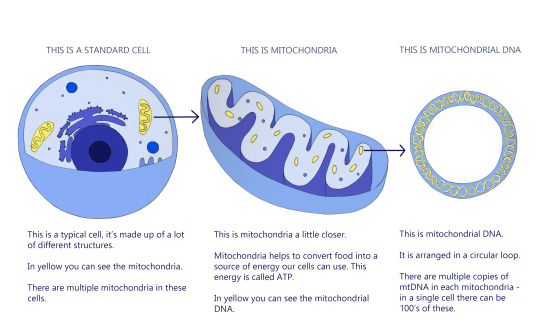
Why is it maternal DNA?
It is often referred to as maternal DNA because it is inherited from the mother only, (unlike nuclear DNA which comes from both parents) there are a couple of reasons for this. Firstly, eggs contain a whole lot more mtDNA than sperm do so there is a significant element of dilution already, secondly, the mtDNA in sperm is located at the base of the tail – just below the head – which can break off and may not necessarily make it into the egg. Finally, the paternal mtDNA that DOES make it into the egg cell only survives for a few days before it begins to break down. Nature has pretty much ensured that mitochondria is only inherited from the mother.

So how does this help forensics?
The good thing about mitochondrial DNA is that it is often still found when only small samples or degraded samples are available, mtDNA can be found in teeth, older bone samples and hair shafts. This is because there are SO MANY copies of it. When you look at the cell you have the single nucleus which contains only two copies of nuclear DNA, but surrounding that nucleus are multiple mitochondria floating around, each containing many copies of mtDNA, meaning in a single cell there will be hundreds of mtDNA copies. In cases of old, unidentified remains, mtDNA may be extracted and used to identify maternal relatives.
But the downside is…
Unlike nuclear DNA which is unique to each individual, mtDNA is shared with all of a woman’s children (both male and female) plus her own siblings, mother and any other maternal relatives. Therefore it cannot be used exclusively to identify an individual, although it can be used to rule out an individual. When mtDNA is used as evidence in court it will form part of the argument but will never be used exclusively. Nuclear DNA is more favourable as evidence as no two people are known to share the same DNA profile. The Illustration below shows the sharing of mtDNA. All those in pink share mtDNA profiles.

Researching this certainly helped me understand and appreciate the science behind mtDNA more, I hope this can be useful for you too.
412 notes
·
View notes
Photo

Examining Shoe Prints And Tire Tracks
Footwear and tire track evidence can be found at the majority of crime scenes. A perpetrator will always have to arrive, commit a crime and then leave the scene in a vehicle or on foot.
This type of evidence can help investigators find out important information like where the crime occurred, how many people or vehicles were present, the direction the perpetrator could have travelled and if the scene is connected to other recent crimes.
Visible prints are transfers of a substance/material from the tire or shoe on to a surface. They can be seen with the naked eye. Example: muddy tire tracks or bloody boot print
Plastic prints are three-dimensional impressions left on a soft surface. These prints can be cast and preserved for later analysis. Example: tracks left in mud, snow or sand
Latent prints are not visible to the naked eye. By using chemicals, powders or alternate light sources these prints can become visible. Example: shoe prints on a window sill or tire tracks on roads or sidewalks
610 notes
·
View notes
Text
A Basic Overview of the Many Different Types of Death
When talking about death forensically, or medically, there are many different categories of death, and types of deaths to consider. Here, I will walk you through some of the basics.
Basic definitions
Thanatology: is the scientific study of death. It investigates the mechanisms and forensic aspects of death, such as bodily changes that accompany death and the post-mortem period, as well as wider social aspects related to death. the types of deaths investigated in a forensic context include:
Violent deaths (accidents, homicides, suicides)
Suspicious deaths
Sudden and unexpected deaths
Deaths without a physician in attendance
Deaths in an institution (such as a prison)
Death: Cessation of life. In lower multicellular organisms, death is a gradual process at the cellular level, because tissues vary in their ability to withstand deprivation of oxygen. In higher organisms, death is a cessation of integrated tissues and organ functions. In humans, death is manifested by the loss of heart beat, the cessation of breathing, and cerebral death.
Cerebral Death: Permanent loss of cerebral and brainstem function, manifested by the absence of responsiveness to external stimuli, absence of cephalic reflexes (reflexes associated with the cranial nerves) and apnea (absence of breathing).
Delayed Deaths: Long delay between injury and death, as long as the death was a result of the injuries. An example of this would be a person being shot, living through the experience, but dying years later from health complications arising from being shot. In such as case as someone being shot, the death may be ruled a homicide, although the death happened years after the initial gunshot, and legal ramifications may be dealt out.
Cause, Mechanism, and Manner of Death
Cause of death: Any injury or disease that produces a physiological derangement in the body that results in the death if the individual.
Mechanism of Death: The physiological derangement produced by the cause of death that results in death.
Manner of Death: Explains how the cause of death came about. They can generally be categorized as:
Natural
Homicide
Suicide
Undetermined
So basically, the cause of death is the initial injury or disease that was inflicted upon a person. The mechanism of death is the body’s resulting reaction to the disease or injury; a biochemical or physiological abnormality is produced. The manner of death is simply used by medical examiners in order to categorize cause and mechanism of death. For example, a person can be shot (the cause of death, the initial injury), and die of a massive hemorrhage (the mechanism of death, the physiological abnormality), and the death is ruled a homicide (the manner of death).
Forensic pathologists evaluate the evidence of a case, as well as the results of the autopsy (if one is performed) in order to determine the manner of death. It is the job of the forensic pathologist to compare the accounts of what happened to the victim, and the forensic evidence and determine if those two things match up or not. For example, a person is found dead due to a fatal gunshot wound. A witness says that the person committed suicide, but the forensic evidence reveals a gunshot wound to the back of the head, inflicted from a distance. The forensic evidence and the account of what happened do not match in this case, which might lead the forensic investigator to determine the manner of death to be homicide instead of suicide.
Subcategories Within Natural Death: Sudden and Unexpected Deaths
Sudden deaths and unexpected deaths are the two most common types of natural deaths. Sudden deaths can be instantaneous, sudden but not instantaneous, or a case where the person was found dead, and it is unclear if it was instantaneous or not.
Sudden, Instantaneous Death
A sudden, instantaneous death can occur in many different forms, but the most common one is someone walking along, and suddenly they collapse, and they are dead upon hitting the ground. The most common cause of this type of death is ventricular arrhythmia due to coronary artery disease. A person who died a sudden, instantaneous death will often show impact abrasions on the bony ridges of their body and face (check bone, forehead, chin, elbows, knees, etc.) The impact abrasions are caused by the individual’s inability to brace their fall; the person is usually dead before they hit the ground, therefore they cannot brace their fall. Impact abrasions are a good way to distinguish an instantaneous death from a sudden, but not instantaneous death.
Sudden, But Not Instantaneous Death
The sudden, but not instantaneous death is simply slower than instantaneous death. The person usually has time to complain of chest pain, difficultly breathing, weakness, sweating, or nausea (or any other symptoms) before they collapse and die. Depending on how long it takes the person to die, the death may not be considered sudden. Most medical examiners consider a death within a hour of the onset of symptoms a sudden death. Usually people who die sudden, but not instantaneous deaths die on the way to the hospital, or in their homes. In their homes, the individuals are usually found in their bed, or in some type of intentional position, as opposed to instantaneous deaths, where the individuals are usually found sprawled on the floor, or in a position indicative of a fall. Individuals who die sudden, but not instantaneous deaths usually do not have impact abrasions, but in some cases, they may.
Unexpected Deaths
There are two types of unexpected deaths, really. There are unexpected deaths that come about because of a car crash, or train derailment, building collapse, a fatal fall, etc. These are unexpected deaths, but the manner of death is usually classified as accidental. In this section, we will talk about unexpected natural deaths. Unexpected natural deaths are usually individuals who are found dead (of some natural cause) and it cannot be determined whether the death was instantaneous or not. The classification of unexpected death is mainly used when the medical examiner cannot determine the type of sudden death that occurred.
1K notes
·
View notes
Photo
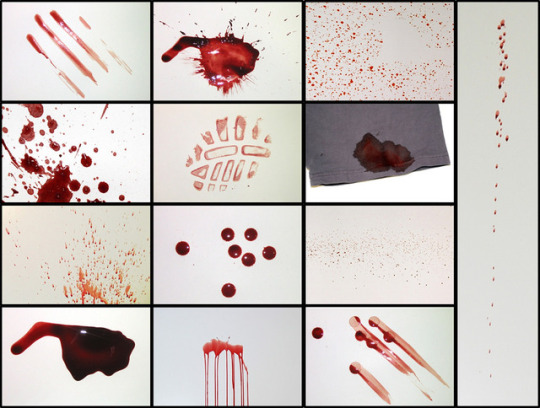
The Basic Categories Bloodstains Are Classified Into
Passive stains
Examples: pools, flows, drops
These stains are usually from gravity acting on an injured body or source of blood.
Transfer stains:
Examples: boot prints, hand prints, wipes
These stains are a result of a bloody object transferring blood onto a surface or object.
Impact stains:
Examples: spatter, splashes, gushes
These stains usually occur when an object or person hits a static pool of blood.
4K notes
·
View notes
Photo
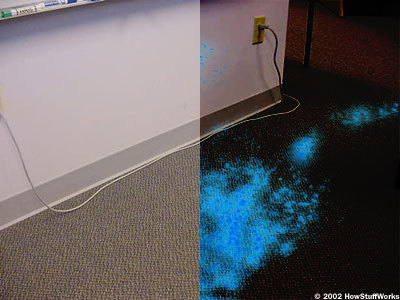

Luminol is a chemical that can be used to show trace amounts of blood by creating a light producing chemical reaction when mixed with hemoglobin.
Luminol powder is mixed into a liquid containing hydrogen peroxide and other chemicals. This mixture will then be sprayed over the area that is being examined.
The reaction of the Luminol spray mixing with the iron in blood will then produce a blue glow that can be seen in a dark room.
Other substances that can accidentally have the same reaction with Luminol are: bleach, urine, faeces & horseradish.
Unfortunately Luminol can destroy other crime scene evidence so it is usually used after other options have been explored.
8K notes
·
View notes